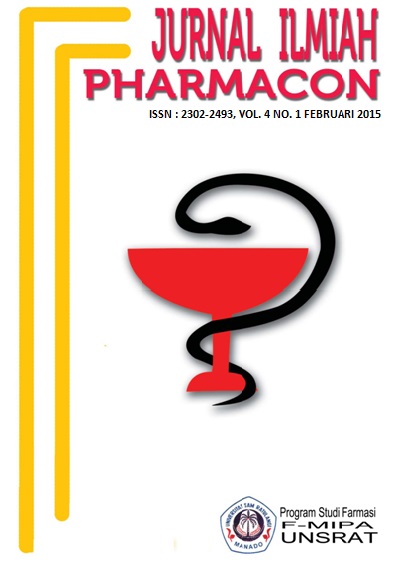AKTIFITAS ANTIBAKTERI DAN KARATERISTIK GUGUS FUNGSI DARI TUNIKATA POLYCARPA AURATA
DOI:
https://doi.org/10.35799/pha.4.2015.6481Abstract
AKTIFITAS ANTIBAKTERI DAN KARATERISTIK GUGUS FUNGSI DARI TUNIKATA POLYCARPA AURATA
Andrio Rainhard Kumayas1), Defny Silvia Wewengkang1), Sri Sudewi1)
Program Studi Farmasi, FMIPA UNSRAT, MANADO
Â
Â
Abstrak
Tujuan penelitian ini untuk mengetahui aktivitas antibakteri dari ekstrak etanol, fraksi methanol, n-heksan dan kloroform dari tunikata Polycarpa aurata terhadap pertumbuhan bakteri Staphylococcus aureus dan Escericia coli. Ekstraksi dilakukan dengan cara maserasi menggunakan pelarut etanol 96%. Fraksinasi dilakukan menggunakan metode partisi dengan pelarut n-heksan, kloroform dan methanol serta pengujian antibakteri dengan menggunakan metode difusi agar Kirby Bauer. Karakterisasi fraksi terbaik terhadap Tunikata Polycarpa aurta dilakukan dengan menggunakan Spektrofotometri UV-Vis dan Spektrofotometri IR. Aktivitas antibakteri paling baik terdapat pada fraksi kloroform dengan daya hambat bakteri Staphylococcus aureus sebesar 8,90 mm, dan Escericia coli sebesar 7,03 mm. Hasil Spektrofotometri UV-Vis menunjukkan dua pita yaitu pada panjang gelombang 348,50 nm dengan absorbansi 0,141, dan  pada panjang gelombang 259,00 nm dengan absorbansi 0,624. Data didukung dengan menggunakan FTIR, muncul serapan pada bilangan gelombang 3120,82 cm-1 yang merupakan karakteristik gugus fungsi N-H. Hasil penelitian ini menyimpulkan bahwa fraksi kloroform Tunikata Polycarpa aurata memiliki kemampuan untuk menghambat bakteri Staphylococcus aureus dan Escericia coli dengan kategori sedang.
Kata kunci : Tunikata Polycarpa aurata, antibakteri, Staphylococcus aureus dan Escericia coli, Spektrofotometer UV-Vis, Spektrofotometer IR.
  AbstractÂ
The purpose of this study to determine the antibacterial activity of ethanol extract, fraction of methanol, n-hexane and chloroform from Tunicates Polycarpa aurata on the growth of Staphylococcus aureus and Escericia coli. Extraction was done by maceration using ethanol 96 %. Fractionation was performed using solvent partition method with n-hexane, chloroform and methanol as well as antibacterial testing using agar diffusion method of Kirby Bauer. Characteristics fraction of the Tunicates Polycarpa aurta best done using Spectro UV-Vis and IR spectrophotometry. Most excellent antibacterial activity present in the chloroform fraction inhibition of Staphylococcus aureus by 8.90 mm​​, and 7.03 mm for Escericia coli. UV-Vis spectrophotometry results indicate that there are two bands at a wavelength of 348.50 nm with 0.141 absorbance, and at a wavelength of 259.00 nm with 0.624 absorbance. Data is supported by using FTIR, appears uptake wave number 3120.82 cm-1 which is characteristics N-H functional groups. The results of this study concluded that chloroform fraction Tunicates Polycarpa aurata has the ability to inhibit Staphylococcus aureus and Escericia coli with moderate category. Keywords : Tunicates Polycarpa aurata, antibacterial, Staphylococcus aureus and Escericia coli, Spectrophotometer UV-Vis , IR spectrophotometer.Â
Downloads
Published
How to Cite
Issue
Section
License
Authors who publish with this journal agree to the following terms:
- Authors retain copyright and grant the journal right of first publication with the work simultaneously licensed under a Creative Commons Attribution-NonCommercial 4.0 International License that allows others to share the work with an acknowledgement of the work's authorship and initial publication in this journal.
- Authors are permitted and encouraged to post their work online (e.g., in institutional repositories or on their website) prior to and during the submission process, as it can lead to productive exchanges, as well as earlier and greater citation of published work (See The Effect of Open Access)










